-
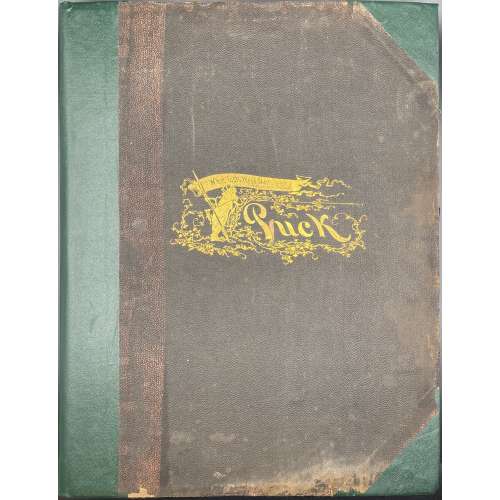 26 issues of American political humourous magazine published by Joseph Keppler (Austrian-American, 1838 – 1894) and Adolph Schwarzmann (German-American, 1838 – 1904) with caricatures by Frederick Burr Opper (American, 1857 – 1937); 35 x 27 cm, bound in faux shagreen with half green buckram backing, gilt vignette and lettering to front board: ‘What fools these Mortals be!” | MIDSUMMER NIGHT'S DREAM | PUCK ||
26 issues of American political humourous magazine published by Joseph Keppler (Austrian-American, 1838 – 1894) and Adolph Schwarzmann (German-American, 1838 – 1904) with caricatures by Frederick Burr Opper (American, 1857 – 1937); 35 x 27 cm, bound in faux shagreen with half green buckram backing, gilt vignette and lettering to front board: ‘What fools these Mortals be!” | MIDSUMMER NIGHT'S DREAM | PUCK || -
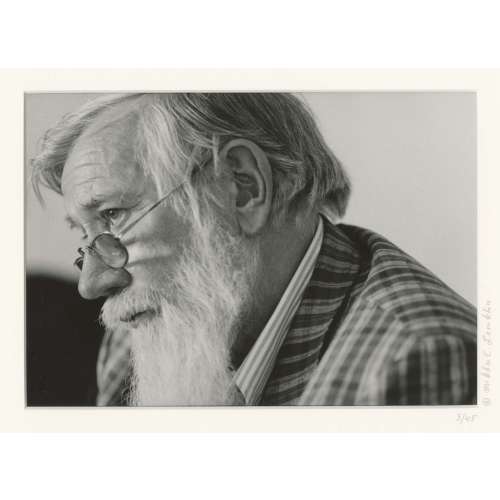 Photographic portrait of writer Andrei Sinyavsky, head and shoulder, turned to the left, wearing glasses. Pencil-signed on the mat: 3/45 • ©Mikhail Lemkhin; on the back of the print: Copyright statement stamp; ink stamp ©MIKHAIL LEMKHIN; ink stamp: PHOTO BY MIKHAIL LEMKHIN | 1811 38TH AVENUE | SAN FRANCISCO, CA 94122 | (415) 664-7677; pencil inscription on the back of the mat: (top) АНДРЕЙ СИНЯВСКИЙ | ANDREI SINYAVSKY, (bottom) XXIX. Sitter: Andrei Sinyavsky [Андрей Донатович Синявский] (Russian, 1925 – 1997) Size: mat: 35.6 x 43.3 cm; window: 16.5 x 23.5 cm; print: 20.2 x 25.2 cm.
Photographic portrait of writer Andrei Sinyavsky, head and shoulder, turned to the left, wearing glasses. Pencil-signed on the mat: 3/45 • ©Mikhail Lemkhin; on the back of the print: Copyright statement stamp; ink stamp ©MIKHAIL LEMKHIN; ink stamp: PHOTO BY MIKHAIL LEMKHIN | 1811 38TH AVENUE | SAN FRANCISCO, CA 94122 | (415) 664-7677; pencil inscription on the back of the mat: (top) АНДРЕЙ СИНЯВСКИЙ | ANDREI SINYAVSKY, (bottom) XXIX. Sitter: Andrei Sinyavsky [Андрей Донатович Синявский] (Russian, 1925 – 1997) Size: mat: 35.6 x 43.3 cm; window: 16.5 x 23.5 cm; print: 20.2 x 25.2 cm. -
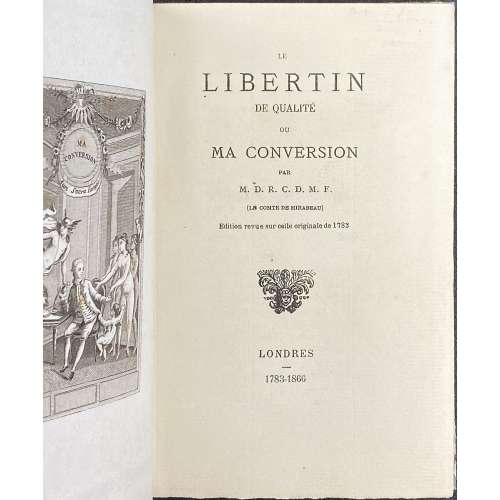 Hardcover volume, 17 x 11.3 cm, in-12, quarter orange cloth (percaline) over marbled boards, black morocco label with gilt lettering to spine, marbled endpapers, text printed on laid paper, five plates on India paper (papier Chine). Title-page: LE | LIBERTIN | DE QUALITÉ | OU | MA CONVERSION | PAR | M. D. R. C. D. M. F. | (LE COMTE DE MIRABEAU) | Edition revue sur celle originale de 1783 | {fleuron} | LONDRES | – | 1783-1866 || Pagination: [4] (h.t., t.p.), [1] 2-200; total 204 pages plus 5 engraved plates, incl. frontispiece; 2 blank leaves at the front and 2 at the back, laid paper, watermarked Canson & Montgolfier. Catalogue raisonné: Dutel I: A-653. Ref.: Illustrations were earlier published in Vie privée, libertine et scandaleuse de feu Honoré-Gabriel Riquetti Comte de Mirabeau, 1791, (see [LIB-2633.2021] Apollinaire, et al. L’Enfer de la Bibliothèque nationale, 1912 : № 795). M. D. R. C. D. M. F stands for Monsieur de Riqueti comte de Mirabeau Fis. Catalogue Poulet-Malassis & ses amis description: № 55. M. D. R. C. D. M. F. (le comte de Mirabeau). Le Libertin de qualité ou Ma conversion, édition revue sur celle de l’originale de 1783. Londres 1783-1866 [Christiaens, 1867]. In-12 de 2 .n.ch. et 200 pages, demi-percaline orange, pièce de titre, tête jaspée, tranches naturelles (reliure de l’époque). Illustré de 5 gravures originales, dont l’une en frontispice, qui reprennent celles de l’édition de Vie privée libertine et scandaleuse de feu Honoré-Gabriel-Riqueti, ci-devant comte de Mirabeau [...] de 1791. Contributors: Honoré-Gabriel Riqueti de Mirabeau (French, 1749 – 1791) – author. Alexis Christiaens (Belgian, d. 1880) – publisher.
Hardcover volume, 17 x 11.3 cm, in-12, quarter orange cloth (percaline) over marbled boards, black morocco label with gilt lettering to spine, marbled endpapers, text printed on laid paper, five plates on India paper (papier Chine). Title-page: LE | LIBERTIN | DE QUALITÉ | OU | MA CONVERSION | PAR | M. D. R. C. D. M. F. | (LE COMTE DE MIRABEAU) | Edition revue sur celle originale de 1783 | {fleuron} | LONDRES | – | 1783-1866 || Pagination: [4] (h.t., t.p.), [1] 2-200; total 204 pages plus 5 engraved plates, incl. frontispiece; 2 blank leaves at the front and 2 at the back, laid paper, watermarked Canson & Montgolfier. Catalogue raisonné: Dutel I: A-653. Ref.: Illustrations were earlier published in Vie privée, libertine et scandaleuse de feu Honoré-Gabriel Riquetti Comte de Mirabeau, 1791, (see [LIB-2633.2021] Apollinaire, et al. L’Enfer de la Bibliothèque nationale, 1912 : № 795). M. D. R. C. D. M. F stands for Monsieur de Riqueti comte de Mirabeau Fis. Catalogue Poulet-Malassis & ses amis description: № 55. M. D. R. C. D. M. F. (le comte de Mirabeau). Le Libertin de qualité ou Ma conversion, édition revue sur celle de l’originale de 1783. Londres 1783-1866 [Christiaens, 1867]. In-12 de 2 .n.ch. et 200 pages, demi-percaline orange, pièce de titre, tête jaspée, tranches naturelles (reliure de l’époque). Illustré de 5 gravures originales, dont l’une en frontispice, qui reprennent celles de l’édition de Vie privée libertine et scandaleuse de feu Honoré-Gabriel-Riqueti, ci-devant comte de Mirabeau [...] de 1791. Contributors: Honoré-Gabriel Riqueti de Mirabeau (French, 1749 – 1791) – author. Alexis Christiaens (Belgian, d. 1880) – publisher. -
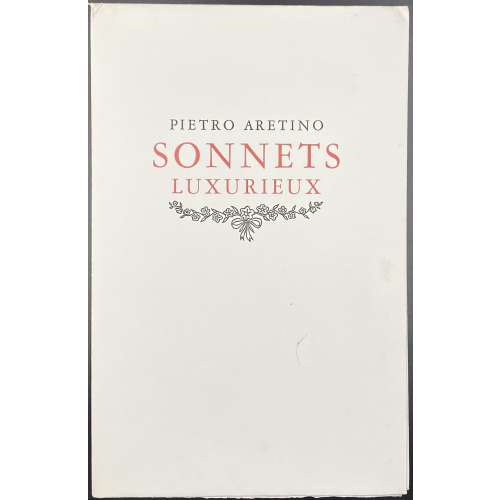 Softcover volume, 25.9 x 16.7 cm, in French flapped wrappers lettered "PIETRO ARETINO | SONNETS | LUXURIEUX | {garland}" unbound, 6 gatherings in 4to (24 leaves, incl. those in wrappers), a few sheets of guard tissue laid in, unpaginated, lower margin untrimmed; in a burgundy double slipcase 26.3 x 17.3 cm. Illustrated with title-page vignette, red initials and tailpieces and 16 half-page engravings by Jean Baptiste Tavy Notton. Text in Italian and French. Title-page (red and black): SONNETS | LUXURIEUX | de | PIETRO ARETINO | dit L'ARÉTIN | avec accompagnement | de gravures au burin | d'après la description des gravures | de GIULIO PIPPI DE GIANNUZZI dit JULES ROMAIN | {vignette} | AUX DÉPENS | DE QUELQUES AMATEURS | 1948 || Clandestine limited edition, print run of 250 copies, of which this is copy № 20, printed on thick wove paper without watermarks. Catalogue raisonné: Dutel III № 2421. Original edition: Sonetti lussuriosi by Pietro Aretino, illustrated by Giulio Romano and engraved by Marcantonio Raimondi, published clandestinely in Venice in c.1527. Contributors: Pietro Aretino (Italian, 1492 – 1556) – author. Jean Baptiste Tavy Notton (French, 1914 – 1971) – artist. Antoine-Isidore Liseux (French, 1835 – 1894) – translator/comments. Giulio Romano [Giulio Pippi, Giulio Giannuzzi] (Italian, c.1499 – 1546) – artist. Marcantonio Raimondi (Italian c. 1470/82 – c. 1534) – engraver.
Softcover volume, 25.9 x 16.7 cm, in French flapped wrappers lettered "PIETRO ARETINO | SONNETS | LUXURIEUX | {garland}" unbound, 6 gatherings in 4to (24 leaves, incl. those in wrappers), a few sheets of guard tissue laid in, unpaginated, lower margin untrimmed; in a burgundy double slipcase 26.3 x 17.3 cm. Illustrated with title-page vignette, red initials and tailpieces and 16 half-page engravings by Jean Baptiste Tavy Notton. Text in Italian and French. Title-page (red and black): SONNETS | LUXURIEUX | de | PIETRO ARETINO | dit L'ARÉTIN | avec accompagnement | de gravures au burin | d'après la description des gravures | de GIULIO PIPPI DE GIANNUZZI dit JULES ROMAIN | {vignette} | AUX DÉPENS | DE QUELQUES AMATEURS | 1948 || Clandestine limited edition, print run of 250 copies, of which this is copy № 20, printed on thick wove paper without watermarks. Catalogue raisonné: Dutel III № 2421. Original edition: Sonetti lussuriosi by Pietro Aretino, illustrated by Giulio Romano and engraved by Marcantonio Raimondi, published clandestinely in Venice in c.1527. Contributors: Pietro Aretino (Italian, 1492 – 1556) – author. Jean Baptiste Tavy Notton (French, 1914 – 1971) – artist. Antoine-Isidore Liseux (French, 1835 – 1894) – translator/comments. Giulio Romano [Giulio Pippi, Giulio Giannuzzi] (Italian, c.1499 – 1546) – artist. Marcantonio Raimondi (Italian c. 1470/82 – c. 1534) – engraver. -
 Paperback, 16.5 x 10.8 cm, pictorial wrappers, lettering to front and spine; pp.: [1-4] 5-187 [188] [4]. Title-page: Венедикт | ЕРОФЕЕВ | Москва – | Петушки | ПОЭМА | ВАГРИУС • МОСКВА • 2003 || Print-run: 11,000. Contributors: Венедикт Васильевич Ерофеев [Venedikt Yerofeyev] (Russian, 1938 – 1990) – author. Вагриус – publisher.
Paperback, 16.5 x 10.8 cm, pictorial wrappers, lettering to front and spine; pp.: [1-4] 5-187 [188] [4]. Title-page: Венедикт | ЕРОФЕЕВ | Москва – | Петушки | ПОЭМА | ВАГРИУС • МОСКВА • 2003 || Print-run: 11,000. Contributors: Венедикт Васильевич Ерофеев [Venedikt Yerofeyev] (Russian, 1938 – 1990) – author. Вагриус – publisher. -
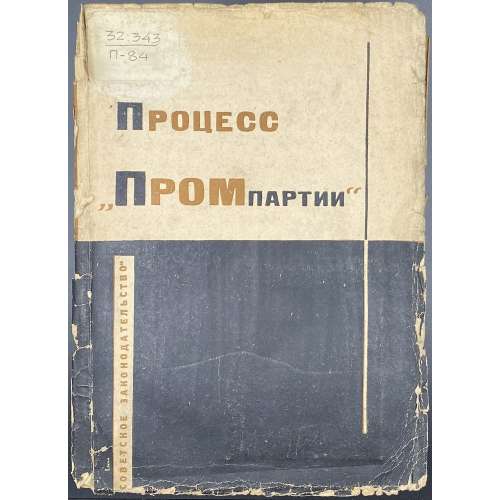 Softcover, 24 x 18 cm, black and white original wrappers, lettering; pp. [1-6] 7-541 [3]; purple ink library stamps and numbers. Title-page: ПРОЦЕСС “ПРОМПАРТИИ” | (25 ноября – 7 декабря 1930 г.) | СТЕНОГРАММА | СУДЕБНОГО ПРОЦЕССА | И МАТЕРИАЛЫ, | ПРИОБЩЕННЫЕ К ДЕЛУ | 1931 | ОГИЗ — “СОВЕТСКОЕ ЗАКОНОДАТЕЛЬСТВО” — МОСКВА || Процесс Промпартии [Industrial Party Trial] Андрей Януарьевич Вышинский [Andrey Vyshinsky] (Russian, 1883 – 1954) – chairman. Николай Васильевич Крыленко [Nikolai Krylenko] (Russian, 1885 – 1938) – public prosecutor.
Softcover, 24 x 18 cm, black and white original wrappers, lettering; pp. [1-6] 7-541 [3]; purple ink library stamps and numbers. Title-page: ПРОЦЕСС “ПРОМПАРТИИ” | (25 ноября – 7 декабря 1930 г.) | СТЕНОГРАММА | СУДЕБНОГО ПРОЦЕССА | И МАТЕРИАЛЫ, | ПРИОБЩЕННЫЕ К ДЕЛУ | 1931 | ОГИЗ — “СОВЕТСКОЕ ЗАКОНОДАТЕЛЬСТВО” — МОСКВА || Процесс Промпартии [Industrial Party Trial] Андрей Януарьевич Вышинский [Andrey Vyshinsky] (Russian, 1883 – 1954) – chairman. Николай Васильевич Крыленко [Nikolai Krylenko] (Russian, 1885 – 1938) – public prosecutor. -
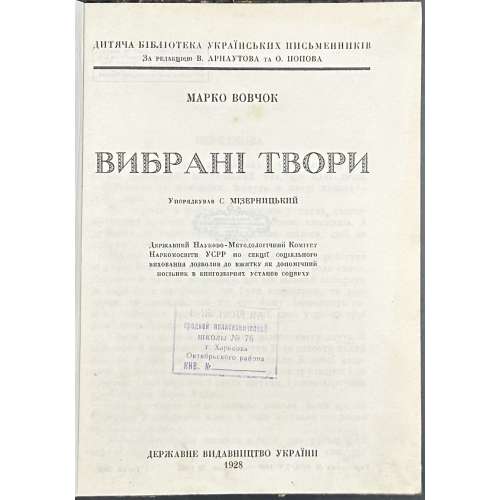 Owner’s quarter cloth over faux marbled paper binding, 19.8 x 15.1 cm, pp.: [1-4] 5-227 [3], total 230 pages plus frontispiece (b/w photographic portrait w/facsimile); library blue ink stamp to t.p. “Библиотека средней политехнической школы № 76 г. Харькова Октябрьского района Инв. № ___». Title-page: ДИТЯЧА БIБЛIОТЕКА УКРАЇНСЬКИХ ПИСЬМЕННИКIВ | За редакцiєю В. АРНАУТОВА та О. ПОПОВА | — | ВИБРАНI ТВОРИ | Упорядкував С. МIЗЕРНИЦЬКИЙ | Державний Науково-Методологiчний Комитет | Наркомосвiти УСРР по секциï сицiяльного | виховання дозволив до вжитку як допомiчний | посiбник в книгозбiрнях установ соцвиху | ДЕРЖАВНЕ ВИДАВНИЦТВО УКРАЇНИ | 1928 || Contents: Передмова, Викуп, Паньска воля (Горпина), Козачка, Ледащиця, Чумак, Не до пари, Тюлева баба, Кармелюк, Гайдамаки. Print run: 5,000 copies. Contributors: Марко Вовчок [Marko Vovchok; Марія Олександрівна Вілінська] (Ukrainian, 1833 – 1907) – author. Other variants: Markowovzok and Marko Vovtchok.
Owner’s quarter cloth over faux marbled paper binding, 19.8 x 15.1 cm, pp.: [1-4] 5-227 [3], total 230 pages plus frontispiece (b/w photographic portrait w/facsimile); library blue ink stamp to t.p. “Библиотека средней политехнической школы № 76 г. Харькова Октябрьского района Инв. № ___». Title-page: ДИТЯЧА БIБЛIОТЕКА УКРАЇНСЬКИХ ПИСЬМЕННИКIВ | За редакцiєю В. АРНАУТОВА та О. ПОПОВА | — | ВИБРАНI ТВОРИ | Упорядкував С. МIЗЕРНИЦЬКИЙ | Державний Науково-Методологiчний Комитет | Наркомосвiти УСРР по секциï сицiяльного | виховання дозволив до вжитку як допомiчний | посiбник в книгозбiрнях установ соцвиху | ДЕРЖАВНЕ ВИДАВНИЦТВО УКРАЇНИ | 1928 || Contents: Передмова, Викуп, Паньска воля (Горпина), Козачка, Ледащиця, Чумак, Не до пари, Тюлева баба, Кармелюк, Гайдамаки. Print run: 5,000 copies. Contributors: Марко Вовчок [Marko Vovchok; Марія Олександрівна Вілінська] (Ukrainian, 1833 – 1907) – author. Other variants: Markowovzok and Marko Vovtchok. -
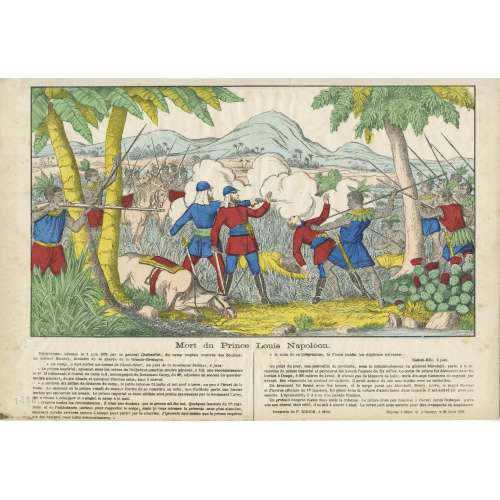 Hand-coloured woodcut on wove paper, 267 x 390 mm. On reverse: black ink stamp “5351”. Centre, under the image frame "Mort du Prince Louis Napoléon". Below left: "Télégramme adressé le 2 juin 1879 par le général Chelmsfort, du camp anglais (contrée des Zoulous), au colonel Stanley, ministre de la guerre de la Grande-Bretagne. « Au camp, à sept milles au-dessus de Blood-River, au pied de la montagne Stellezi, 2 juin: Le prince impérial, agissant sous les ordres de l'adjudant quartier-maitre général. a fait une reconnaissance le 1er. Il retournait à cheval au camp le 2 accompagné du lieutenant Carey, du 98e adjudant en second du quartier-maitre général. de six blancs et, quelques Zoulous amis, tous à cheval. A environ dix milles de distance du camp, la petite colonne fit halte at mit pied à terre, un peu à l’écart de la route. Au moment ou le prince venait de donner l'ordre de se remettre en selle. une fusillade partit des hautes herbes qui entourant les kraals. Le prince impérial et deux soldats sont portés manquants par le lieutenant Carey, qui a réussi à échapper et a gagné le camp à la nuit. D'après toutes les circonstances, il 'est pas douteux quo le prince ait été tué. Quelques lanciers du 17 régiment et de l'ambulance partent pour rapporter le corps; mais je vous adresse la présente sans plus attendre, espérant qu'elle arrivera encore à temps pour partir par le courrier. J’ignorais moi-même que le prince impérial eût été désigné pour cette reconnaissance. »" Below right: A la suite de le télégramme, le Times publie les dépêches suivantes: Stelezi-Hill, 2 juin. Au point du jour, une patrouille de cavalerie, sous le commandement du général Marshall. partit à la recherche du prince impérial et parcourut les kraals l'espace de dix milles. Le corps du prince fut découvert dans les herbes à Donga, à 300 mètres du kraal. Il n'avait pas de blessure de balle, mais dix-sept blessures de zagaies par devant. Ses vêtements lui avaient été enlevés. I avait autour du cou une chaine avec un médaillon. Un brancard fut formé avec les lances, et le corps porté par Marchall, Drury, Lowe, le mjor Stewart et d'autres officiers du 17e lanciers, fut. place dans la voiture d'ambulance dans laquelle il est arrivé ici avec une escorte. L'après-midi, il v a eu une parade funèbre. Un profond chagrin règne dans toute la colonne. Le prince n'est pas remonté à cheval après l’attique, parce que son cheval était rétif ; il se mit à courir à pied. Le corps part sous escorte pour être transporté en Angleterre. Bottom right: "Imagerie de P. DIDION, à Metz — Déposé à Metz et à Nancy, le 25 Juin 1879". Paulin Didion (French, 1831 – 1879) – publisher/printer.
Hand-coloured woodcut on wove paper, 267 x 390 mm. On reverse: black ink stamp “5351”. Centre, under the image frame "Mort du Prince Louis Napoléon". Below left: "Télégramme adressé le 2 juin 1879 par le général Chelmsfort, du camp anglais (contrée des Zoulous), au colonel Stanley, ministre de la guerre de la Grande-Bretagne. « Au camp, à sept milles au-dessus de Blood-River, au pied de la montagne Stellezi, 2 juin: Le prince impérial, agissant sous les ordres de l'adjudant quartier-maitre général. a fait une reconnaissance le 1er. Il retournait à cheval au camp le 2 accompagné du lieutenant Carey, du 98e adjudant en second du quartier-maitre général. de six blancs et, quelques Zoulous amis, tous à cheval. A environ dix milles de distance du camp, la petite colonne fit halte at mit pied à terre, un peu à l’écart de la route. Au moment ou le prince venait de donner l'ordre de se remettre en selle. une fusillade partit des hautes herbes qui entourant les kraals. Le prince impérial et deux soldats sont portés manquants par le lieutenant Carey, qui a réussi à échapper et a gagné le camp à la nuit. D'après toutes les circonstances, il 'est pas douteux quo le prince ait été tué. Quelques lanciers du 17 régiment et de l'ambulance partent pour rapporter le corps; mais je vous adresse la présente sans plus attendre, espérant qu'elle arrivera encore à temps pour partir par le courrier. J’ignorais moi-même que le prince impérial eût été désigné pour cette reconnaissance. »" Below right: A la suite de le télégramme, le Times publie les dépêches suivantes: Stelezi-Hill, 2 juin. Au point du jour, une patrouille de cavalerie, sous le commandement du général Marshall. partit à la recherche du prince impérial et parcourut les kraals l'espace de dix milles. Le corps du prince fut découvert dans les herbes à Donga, à 300 mètres du kraal. Il n'avait pas de blessure de balle, mais dix-sept blessures de zagaies par devant. Ses vêtements lui avaient été enlevés. I avait autour du cou une chaine avec un médaillon. Un brancard fut formé avec les lances, et le corps porté par Marchall, Drury, Lowe, le mjor Stewart et d'autres officiers du 17e lanciers, fut. place dans la voiture d'ambulance dans laquelle il est arrivé ici avec une escorte. L'après-midi, il v a eu une parade funèbre. Un profond chagrin règne dans toute la colonne. Le prince n'est pas remonté à cheval après l’attique, parce que son cheval était rétif ; il se mit à courir à pied. Le corps part sous escorte pour être transporté en Angleterre. Bottom right: "Imagerie de P. DIDION, à Metz — Déposé à Metz et à Nancy, le 25 Juin 1879". Paulin Didion (French, 1831 – 1879) – publisher/printer. -
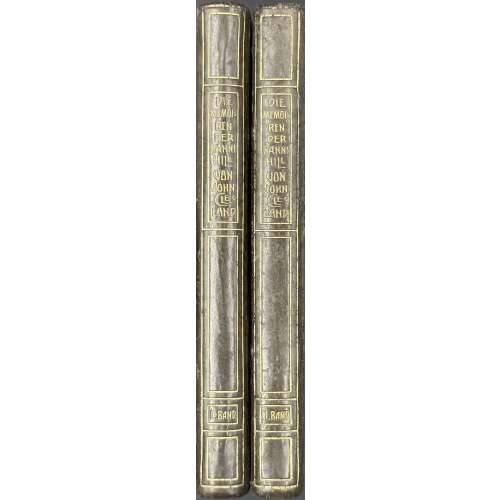 Two hardcover volumes, 17 x 11.5 cm, collated in-8vo, uniformly bound in dark grey mottled calf bordered with gilt fillet, flat spine with gilt lettering in compartments outlined in gilt; top edge gilt, text and plates printed on dense wove paper (Japanpapier). Privately printed by Gustav Röttig & Sohn (Ödenburg) in 800 copies, of which this is copy № 16, signed by von Bayros in 1st vol. Each volume is illustrated with four heliogravures (title-page and three plates) after drawings by Franz von Bayros. According to the seller, this is one of only 35 copies of the deluxe edition on Japanpapier, a fact which was mentioned by the bibliographers but not in the imprint. Bookplate to front pastedown in each volume, lettering to bottom “Ex libris Dr. phil. Rudolf Ludwig”, 120 x 100 mm, heliogravure after von Bayros. Pp.: vol. 1 [4] 1-198 plus engraved t.p. and 3 plates. Vol. 2: 1-204 [2] plus engraved t.p. and 3 plates. Title-page: DIE MEMOIREN | DER | FANNY HILL | VON | JOHN CLELAND | ESTER (ZWEITER) BAND | PAPHOS IM JAHR DER | CYTHERE | MDCCCCVI || Author of the text: John Cleland (British, c. 1709 – 1789). Translator: Franz Blei [Dr. Erich Feldhammer] (Austrian, 1871 – 1942). Illustrator: Franz von Bayros (Austrian, 1866 – 1924). Provenance: Dr. Phil. Rudolf Ludwig. Catalogue raisonné: The amorous drawings of the Marquis von Bayros. — New York: Cythera Press, 1968. The Beautiful Maiden of Pao, pp. 31-38. Seller's Description: Erster [und] Zweiter Band. Paphos [Wien, C. W. Stern], im Jahr der Cythere 1906. Mit sechs Tafeln und zwei illustrierten Titeln nach Franz von Bayros, alle zweifarbig. Grau marmorierte Originalkalblederbände mit Rücken-, Deckelkanten- und Kopfschnittvergoldung. Privatdruck. – Eins von 35 Exemplaren der Luxusausgabe auf Japanpapier, im Druckvermerk von Band I von Bayros signiert. – Die Übersetzung stammt von Franz Blei, der hier unter dem Pseudonym Dr. Erich Feldhammer genannt wird. Als Textvorlage diente die Ausgabe London 1749. – Gedruckt wurde bei Gustav Röttig & Sohn in Ödenburg. – Sehr seltene Vorzugsausgabe, die zwar bei den Bibliographen, nicht aber im Druckvermerk genannt wurde. – Fast tadellos. – »Dieses Werk ist eines der berühmtesten in der erotischen Literatur« (Stern-Szana). Nach Hinweis bei Brettschneider wurde die Auflage beschlagnahmt. – Exlibris Dr. phil. Rudolf Ludwig, Wien (Heliogravüre nach Zeichnung von Franz von Bayros, Brettschneider 156) in beiden Bänden. 17 : 11,5 cm. [4], 198, [2], [4], 204, [2] Seiten. Zusammen 8 Tafeln. Brettschneider 38. – Hayn/Gotendorf I, 618. – Stern-Szana 243 und ausführlich S. 222ff
Two hardcover volumes, 17 x 11.5 cm, collated in-8vo, uniformly bound in dark grey mottled calf bordered with gilt fillet, flat spine with gilt lettering in compartments outlined in gilt; top edge gilt, text and plates printed on dense wove paper (Japanpapier). Privately printed by Gustav Röttig & Sohn (Ödenburg) in 800 copies, of which this is copy № 16, signed by von Bayros in 1st vol. Each volume is illustrated with four heliogravures (title-page and three plates) after drawings by Franz von Bayros. According to the seller, this is one of only 35 copies of the deluxe edition on Japanpapier, a fact which was mentioned by the bibliographers but not in the imprint. Bookplate to front pastedown in each volume, lettering to bottom “Ex libris Dr. phil. Rudolf Ludwig”, 120 x 100 mm, heliogravure after von Bayros. Pp.: vol. 1 [4] 1-198 plus engraved t.p. and 3 plates. Vol. 2: 1-204 [2] plus engraved t.p. and 3 plates. Title-page: DIE MEMOIREN | DER | FANNY HILL | VON | JOHN CLELAND | ESTER (ZWEITER) BAND | PAPHOS IM JAHR DER | CYTHERE | MDCCCCVI || Author of the text: John Cleland (British, c. 1709 – 1789). Translator: Franz Blei [Dr. Erich Feldhammer] (Austrian, 1871 – 1942). Illustrator: Franz von Bayros (Austrian, 1866 – 1924). Provenance: Dr. Phil. Rudolf Ludwig. Catalogue raisonné: The amorous drawings of the Marquis von Bayros. — New York: Cythera Press, 1968. The Beautiful Maiden of Pao, pp. 31-38. Seller's Description: Erster [und] Zweiter Band. Paphos [Wien, C. W. Stern], im Jahr der Cythere 1906. Mit sechs Tafeln und zwei illustrierten Titeln nach Franz von Bayros, alle zweifarbig. Grau marmorierte Originalkalblederbände mit Rücken-, Deckelkanten- und Kopfschnittvergoldung. Privatdruck. – Eins von 35 Exemplaren der Luxusausgabe auf Japanpapier, im Druckvermerk von Band I von Bayros signiert. – Die Übersetzung stammt von Franz Blei, der hier unter dem Pseudonym Dr. Erich Feldhammer genannt wird. Als Textvorlage diente die Ausgabe London 1749. – Gedruckt wurde bei Gustav Röttig & Sohn in Ödenburg. – Sehr seltene Vorzugsausgabe, die zwar bei den Bibliographen, nicht aber im Druckvermerk genannt wurde. – Fast tadellos. – »Dieses Werk ist eines der berühmtesten in der erotischen Literatur« (Stern-Szana). Nach Hinweis bei Brettschneider wurde die Auflage beschlagnahmt. – Exlibris Dr. phil. Rudolf Ludwig, Wien (Heliogravüre nach Zeichnung von Franz von Bayros, Brettschneider 156) in beiden Bänden. 17 : 11,5 cm. [4], 198, [2], [4], 204, [2] Seiten. Zusammen 8 Tafeln. Brettschneider 38. – Hayn/Gotendorf I, 618. – Stern-Szana 243 und ausführlich S. 222ff -
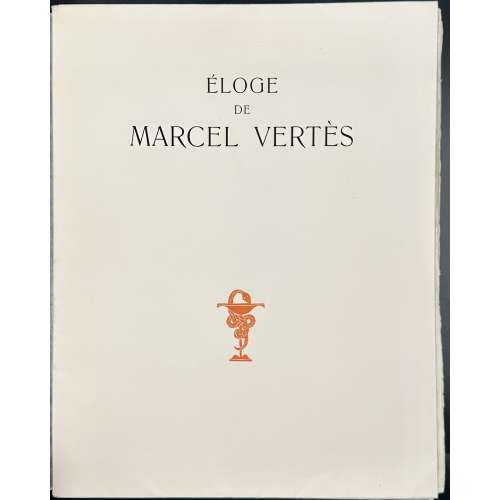 Softcover, 325 x 253 mm, publisher’s French flapped wrappers in glassine dust cover, 15 leaves folio folded in half, making 30 in-2o leaves 321 x 250 mm, with two leaves within the wrappers, [1] t.p., [2] Vertès’ blue ink inscription “À Alexaner Sternberg frère Nicolas qui est un garçon charmant et un bon artiste. Vertès.” and drawing, [3] frontispiece, [4-26] text with six full-page, one head- and one tailpiece in dry point technique, with guard tissues, [27] list of plates, [28] colophon, [29] blank; some page numbers manually scripted in pencil to the bottom right corners by a previous owner. Paper watermarked “BFK Rives”. Title-page (in orange and black): ÉLOGE | DE | MARCEL VERTÈS | PAR | GEORGES HUISMAN | ORNÉ | DE GRAVURES ORIGINALES | {publisher’s device} | MANUEL BRUKER ÉDITEUR || Colophon: CET OUVRAGE A ÉTÉ ACHEVÉ D'IMPRIMER SUR LES PRESSES DE L'IMPRIMERIE DARAGNÈS LE 30 OCTOBRE 1951 A 200 EXEMPLAIRES NUMÉROTÉS DONT 20 SUR VÉLIN 'ARCHES DE 1 A 20 AUXQUELS IL A ÉTÉ JOINT UNE SUITE DES GRAVURES SUR JAPON NACRÉ ET 180 SUR VÉLIN BLANC DE RIVES DE 21 A 200. ON A TIRÉ EN OUTRE 20 SUITES SUR MALACCA DES PLANCHES REFUSÉES. EXEMPLAIRE N° 93. Limitation: 200 copies printed on October 30, 1951, at Daragnès press: 20 (№№ 1-20) on Arches vellum paper with a suite of plates on Japon Nacré and 180 (№№ 21-200) Vélin Blanc by Rives. This is copy № 93. Tipped in: (1) photo of Vertès (and one more) in front of his murals, with the blue ballpoint pen inscription “À Alex Sternberg, frère de Nicola, excellent ami, excellent artiste et voyez, quel photographe!!! Vertès”; (2) postcard with a signed invitation to Vertès' exhibition by Librairie M.-P. Tremois: “Carte Postale | Paris, le 2 mars [19]28 | Monsieur, | Du 6 au 24 mars, | de 2 heures à 6h30, aura | lieu à la Librairie M.-P. Trémois | 43 avenue Rapp, 7e, une | exposition de dessins et | aquarelles de Vertès, ayant | servi à l’illustration de livres. | Nous espérons que vous | voudrez bien nous honorer | de votre visite. M.-P. Trémois.” The drypoint technique is confirmed by the presence of a white line in the middle of the black printed line on the micro photo:
Softcover, 325 x 253 mm, publisher’s French flapped wrappers in glassine dust cover, 15 leaves folio folded in half, making 30 in-2o leaves 321 x 250 mm, with two leaves within the wrappers, [1] t.p., [2] Vertès’ blue ink inscription “À Alexaner Sternberg frère Nicolas qui est un garçon charmant et un bon artiste. Vertès.” and drawing, [3] frontispiece, [4-26] text with six full-page, one head- and one tailpiece in dry point technique, with guard tissues, [27] list of plates, [28] colophon, [29] blank; some page numbers manually scripted in pencil to the bottom right corners by a previous owner. Paper watermarked “BFK Rives”. Title-page (in orange and black): ÉLOGE | DE | MARCEL VERTÈS | PAR | GEORGES HUISMAN | ORNÉ | DE GRAVURES ORIGINALES | {publisher’s device} | MANUEL BRUKER ÉDITEUR || Colophon: CET OUVRAGE A ÉTÉ ACHEVÉ D'IMPRIMER SUR LES PRESSES DE L'IMPRIMERIE DARAGNÈS LE 30 OCTOBRE 1951 A 200 EXEMPLAIRES NUMÉROTÉS DONT 20 SUR VÉLIN 'ARCHES DE 1 A 20 AUXQUELS IL A ÉTÉ JOINT UNE SUITE DES GRAVURES SUR JAPON NACRÉ ET 180 SUR VÉLIN BLANC DE RIVES DE 21 A 200. ON A TIRÉ EN OUTRE 20 SUITES SUR MALACCA DES PLANCHES REFUSÉES. EXEMPLAIRE N° 93. Limitation: 200 copies printed on October 30, 1951, at Daragnès press: 20 (№№ 1-20) on Arches vellum paper with a suite of plates on Japon Nacré and 180 (№№ 21-200) Vélin Blanc by Rives. This is copy № 93. Tipped in: (1) photo of Vertès (and one more) in front of his murals, with the blue ballpoint pen inscription “À Alex Sternberg, frère de Nicola, excellent ami, excellent artiste et voyez, quel photographe!!! Vertès”; (2) postcard with a signed invitation to Vertès' exhibition by Librairie M.-P. Tremois: “Carte Postale | Paris, le 2 mars [19]28 | Monsieur, | Du 6 au 24 mars, | de 2 heures à 6h30, aura | lieu à la Librairie M.-P. Trémois | 43 avenue Rapp, 7e, une | exposition de dessins et | aquarelles de Vertès, ayant | servi à l’illustration de livres. | Nous espérons que vous | voudrez bien nous honorer | de votre visite. M.-P. Trémois.” The drypoint technique is confirmed by the presence of a white line in the middle of the black printed line on the micro photo: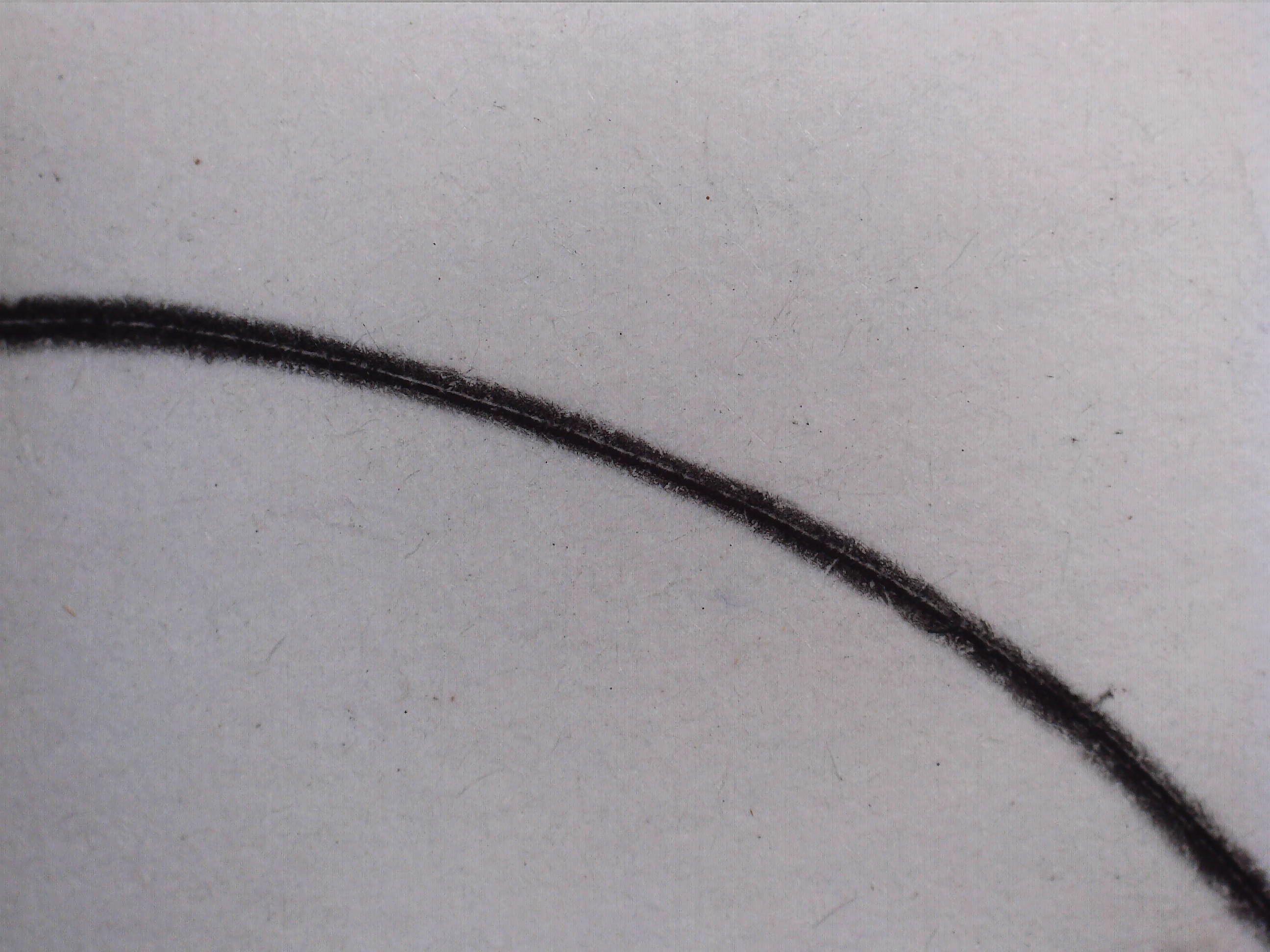 Catalogue raisonné: Vokaer № 52.
Contributors:
Georges Huisman (French, 1889 – 1957) – author.
Marcel Vertès [Marcell Vértes] (Jewish-Hungarian-French, 1895 – 1961) – character/artist.
Manuel Bruker (French, 1891 – 1979) – publisher.
Jean-Gabriel Daragnès (French, 1886 – 1950) – printer.
Nicolas Sternberg (Hungarian-French, 1902 –1960)
Librairie M.-P. Trémois (1925 – 1953)
Catalogue raisonné: Vokaer № 52.
Contributors:
Georges Huisman (French, 1889 – 1957) – author.
Marcel Vertès [Marcell Vértes] (Jewish-Hungarian-French, 1895 – 1961) – character/artist.
Manuel Bruker (French, 1891 – 1979) – publisher.
Jean-Gabriel Daragnès (French, 1886 – 1950) – printer.
Nicolas Sternberg (Hungarian-French, 1902 –1960)
Librairie M.-P. Trémois (1925 – 1953) -
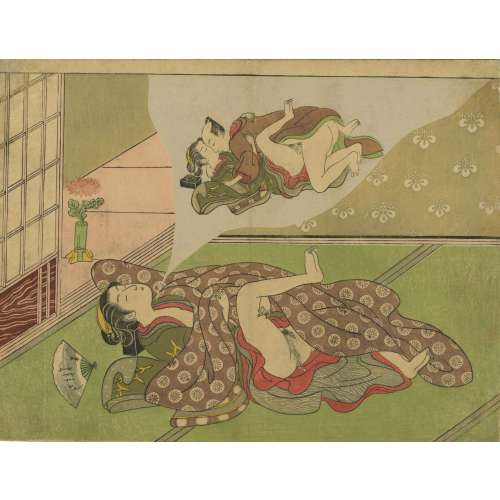 Attributed to Suzuki Harunobu (Japanese: 鈴木 春信; c. 1725 – 7 July 1770). Sunga. Woman dreaming of making love. British museum attributes to Ippitsusai Buncho (一筆斉文調).
Attributed to Suzuki Harunobu (Japanese: 鈴木 春信; c. 1725 – 7 July 1770). Sunga. Woman dreaming of making love. British museum attributes to Ippitsusai Buncho (一筆斉文調). -

Монтескье Шарль Луи. Избранные произведения. // Институт философии АН СССР. - М.: Государственное издательство политической литературы, 1955. - 803 стр. Общая редакция и вступительная статья проф. М. П. Баткина.
Размышления о причинах величия и падения римлян.
О Духе законов.
Опыт о вкусе в произведениях природы и искусства.
Библиография русских переводов произведений Монтескье.
Указатель имен.
-
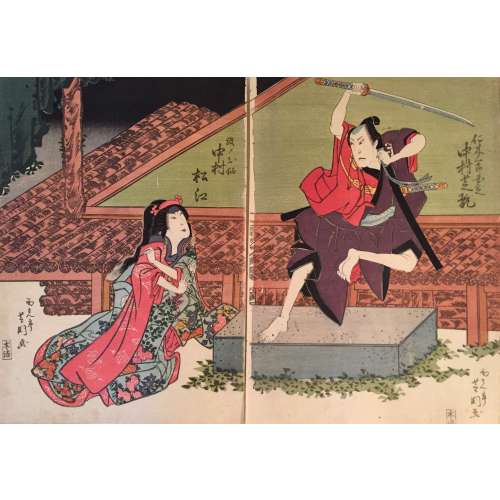 Saikotei Shibakuni (active 1821-1826). Osaka school. Play: Kinoshitakage Hazuma Gassen. Theatre: Nakamura-za /Naka-za (Osaka). Date: 7/1826. Horizontal oban diptych. SV: Nakamura Matsue III (Nakamura Tomijuro II) as female, Nakamura Utaemon III (Nakamura Shikan I) as a male. Publisher: Honya Seishichi [Marks 25-527 | 123f], Honsei, 1817-1838.
Saikotei Shibakuni (active 1821-1826). Osaka school. Play: Kinoshitakage Hazuma Gassen. Theatre: Nakamura-za /Naka-za (Osaka). Date: 7/1826. Horizontal oban diptych. SV: Nakamura Matsue III (Nakamura Tomijuro II) as female, Nakamura Utaemon III (Nakamura Shikan I) as a male. Publisher: Honya Seishichi [Marks 25-527 | 123f], Honsei, 1817-1838. -
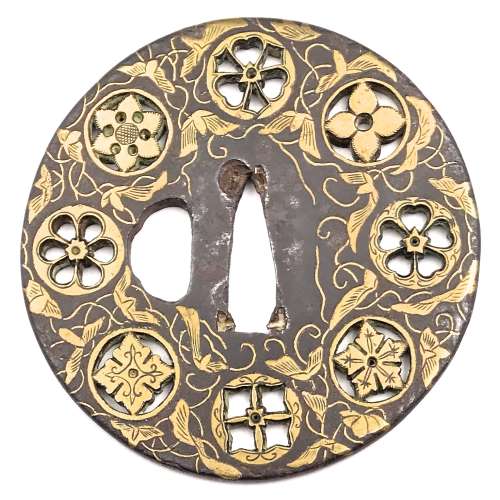 Iron tsuba of round form decorated with eight circular emblems of flowers and/or family crests (mon) made of cast brass, pierced and chiseled in kebori, as well as with flat brass inlay (hira-zōgan) of vines, leaves, and flowers all over the plate. Yoshirō school (Kaga-Yoshirō). The Momoyama or early Edo period, 17th century. Size: diameter 80 mm, thickness at seppa-dai 3,6 mm. Symbols: [12:00 o'clock] - Wood sorrel (katabami) and swords ; [9:00] - Cherry blossom (sakura); [7:30] - Bellflower (kikyō), kamon of Toki clan; [3:00] - possibly, a six-petal Chrysanthemum (kiku) or a Passion flower (tessen); [1:30] - Hemp (asanoha). The symbols at 6:00, 10:30, and 4:30 o'clock seem to be geometrical patterns of auspicious meaning: a cross in a square, a four pointing star, and a diamond, respectively. Alternatively, we may look at this piece as purely decorative, with patterns at 12:00, 3:00, 6:00, and 9:00 o'clock in negative openwork (in-sukashi), and at 1:30, 4:40, 7:20, and 10:30 o'clock - in positive openwork (ji-sukashi, or yō-sukashi). Markus Sesko in his Handbook of sword fittings related terms [Herstellung und Verlag: Books on Demand GmbH, Norderstedt, 2011] discriminates this type of openwork in a separate class: Ranma-sukashi: "This term is applied to circular sukashi with family crests to their inside, which are arranged running along the rim area. The description goes back to the opened boards (ranma) between the sliding doors and the ceiling of Japanese rooms. Ranma-sukashi are mostly seen on old Heianjō- or Yoshirō-zōgan-tsuba but also on works of Hayashi Matashichi" [page 30].
Iron tsuba of round form decorated with eight circular emblems of flowers and/or family crests (mon) made of cast brass, pierced and chiseled in kebori, as well as with flat brass inlay (hira-zōgan) of vines, leaves, and flowers all over the plate. Yoshirō school (Kaga-Yoshirō). The Momoyama or early Edo period, 17th century. Size: diameter 80 mm, thickness at seppa-dai 3,6 mm. Symbols: [12:00 o'clock] - Wood sorrel (katabami) and swords ; [9:00] - Cherry blossom (sakura); [7:30] - Bellflower (kikyō), kamon of Toki clan; [3:00] - possibly, a six-petal Chrysanthemum (kiku) or a Passion flower (tessen); [1:30] - Hemp (asanoha). The symbols at 6:00, 10:30, and 4:30 o'clock seem to be geometrical patterns of auspicious meaning: a cross in a square, a four pointing star, and a diamond, respectively. Alternatively, we may look at this piece as purely decorative, with patterns at 12:00, 3:00, 6:00, and 9:00 o'clock in negative openwork (in-sukashi), and at 1:30, 4:40, 7:20, and 10:30 o'clock - in positive openwork (ji-sukashi, or yō-sukashi). Markus Sesko in his Handbook of sword fittings related terms [Herstellung und Verlag: Books on Demand GmbH, Norderstedt, 2011] discriminates this type of openwork in a separate class: Ranma-sukashi: "This term is applied to circular sukashi with family crests to their inside, which are arranged running along the rim area. The description goes back to the opened boards (ranma) between the sliding doors and the ceiling of Japanese rooms. Ranma-sukashi are mostly seen on old Heianjō- or Yoshirō-zōgan-tsuba but also on works of Hayashi Matashichi" [page 30]. -
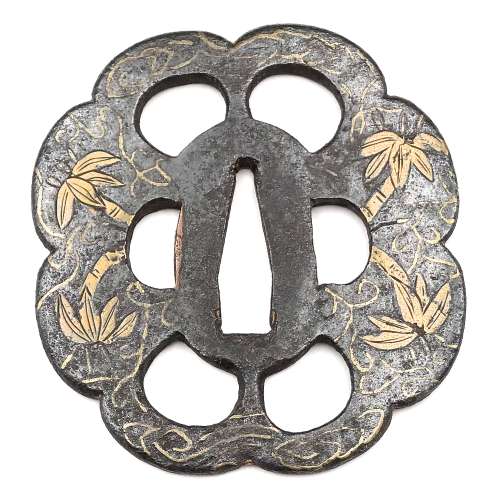 Iron tsuba of 8-lobed form pierced with six openings (sukashi) and decorated with design of bamboo and arabesque in flat brass inlay (hira-zōgan). Two of the openings serve as hitsu-ana. The design on the face represents bamboo trunks and leaves, clouds, waves, and vines; on the back - vines and leaves, that forms an arabesque (karakusa) motif. Rounded square rim. 'Silver' patina. Hitsu-ana with copper sekigane. Heianjō (most probable) or Kaga-Yoshirō school. Late Muromachi or Momoyama period; 16th century. Size: Height: 74.6 mm; Width: 69.5 mm; Thickness at seppa-dai: 4.2 mm. Weight: 113.9 g. Provenance: Gary D. Murtha. This tsuba is illustrated at: Japanese sword guards. Onin - Heianjo - Yoshiro by Gary D. Murtha [GDM Publications, 2016, p. 48]: "Iron, 80x75x3 mm tsuba with brass karakusa vines and leaves on one side with bamboo, leaves, and clouds on the reverse. This tsuba is one of those pieces that might be classified as Onin or Heianjo work, but the flush inlay tips it to the Heianjo side. Late Muromachi period." I would like to add that it easily may also be classified as Kaga-Yoshirō. Robert Haynes in Study Collection.., page 32, illustrates a look-a-like example, and writes: "This style of inlay, where the designs on the face and the back are very different, was common to the work of artists in Kyoto in the Momoyama period."
Iron tsuba of 8-lobed form pierced with six openings (sukashi) and decorated with design of bamboo and arabesque in flat brass inlay (hira-zōgan). Two of the openings serve as hitsu-ana. The design on the face represents bamboo trunks and leaves, clouds, waves, and vines; on the back - vines and leaves, that forms an arabesque (karakusa) motif. Rounded square rim. 'Silver' patina. Hitsu-ana with copper sekigane. Heianjō (most probable) or Kaga-Yoshirō school. Late Muromachi or Momoyama period; 16th century. Size: Height: 74.6 mm; Width: 69.5 mm; Thickness at seppa-dai: 4.2 mm. Weight: 113.9 g. Provenance: Gary D. Murtha. This tsuba is illustrated at: Japanese sword guards. Onin - Heianjo - Yoshiro by Gary D. Murtha [GDM Publications, 2016, p. 48]: "Iron, 80x75x3 mm tsuba with brass karakusa vines and leaves on one side with bamboo, leaves, and clouds on the reverse. This tsuba is one of those pieces that might be classified as Onin or Heianjo work, but the flush inlay tips it to the Heianjo side. Late Muromachi period." I would like to add that it easily may also be classified as Kaga-Yoshirō. Robert Haynes in Study Collection.., page 32, illustrates a look-a-like example, and writes: "This style of inlay, where the designs on the face and the back are very different, was common to the work of artists in Kyoto in the Momoyama period." -
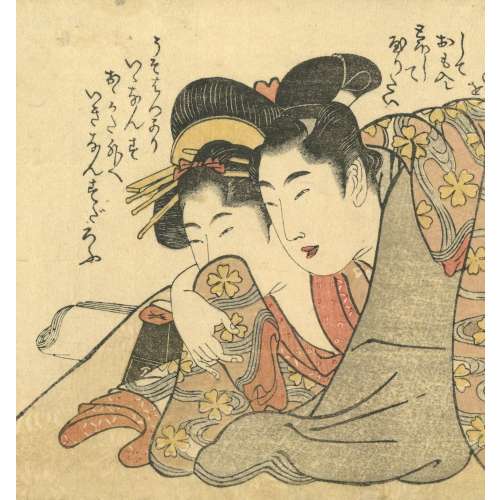 Artist: Kitagawa Utamaro [喜多川 歌麿] (Japanese, c. 1753 – 1806) "This uncommon half-size horizontal ōban ... is most likely one design from a set of twelve prints issued late in Utamaro's life" [Japanese Erotic Fantasies, Hotei Publishing, 2005, p. 143, pl. 47]. Half-size horizontal ōban must be 12.7 x 38 cm. Richard Waldman and Chris Uhlenbeck say it's tanzaku size (13 x 43 cm). In reality, the prints of this series measure 17 x 38 cm, which corresponds exactly to horizontal o-hosoban paper size. I managed to assemble 11 of allegedly 12 designs. 7 of them have genitals colored by hand. It's hard to tell whether it was done by the publisher on demand of a peculiar buyer, or by the owner of the prints who considered the black and white privy parts unnatural. My sequencing of the prints is arbitrary. Transcription of the text may help find the correct order.
Artist: Kitagawa Utamaro [喜多川 歌麿] (Japanese, c. 1753 – 1806) "This uncommon half-size horizontal ōban ... is most likely one design from a set of twelve prints issued late in Utamaro's life" [Japanese Erotic Fantasies, Hotei Publishing, 2005, p. 143, pl. 47]. Half-size horizontal ōban must be 12.7 x 38 cm. Richard Waldman and Chris Uhlenbeck say it's tanzaku size (13 x 43 cm). In reality, the prints of this series measure 17 x 38 cm, which corresponds exactly to horizontal o-hosoban paper size. I managed to assemble 11 of allegedly 12 designs. 7 of them have genitals colored by hand. It's hard to tell whether it was done by the publisher on demand of a peculiar buyer, or by the owner of the prints who considered the black and white privy parts unnatural. My sequencing of the prints is arbitrary. Transcription of the text may help find the correct order. As Japanese Erotic Fantasies put it: "a couple engaged in love-making, their stare fixed outside the picture plane". This is the only image of series that has a reference in available western literature, and the only one found in museum collections: Rijksmuseum Amsterdam (RP-P-1999-2001-16); reference: Fukuda (ed.) (1990), pls. 11-2.
As Japanese Erotic Fantasies put it: "a couple engaged in love-making, their stare fixed outside the picture plane". This is the only image of series that has a reference in available western literature, and the only one found in museum collections: Rijksmuseum Amsterdam (RP-P-1999-2001-16); reference: Fukuda (ed.) (1990), pls. 11-2.
 The scene of this print looks quite similar to that of the Kiyonaga's Sode no maki:
The scene of this print looks quite similar to that of the Kiyonaga's Sode no maki:
 The woman is "a young lady-in-waiting of Shogun's Court or Daimyō's Mansion, enjoying a rare outing from her tedious chores" [Richard Lane]. She is fully dressed in her outer cloak (shikake), white paper hat (agebōshi or tsunokakushi), and toed socks (tabi). A book or maybe, onkotogami (roll of tissues known as 'paper for honourable act' ) is still in the folds of her kimono. She is holding an open fan, either to cover her and her lover's faces from an unsolicited witness or to bring some fresh air to their joined lips. The pair just started their sexual intercourse.
The woman is "a young lady-in-waiting of Shogun's Court or Daimyō's Mansion, enjoying a rare outing from her tedious chores" [Richard Lane]. She is fully dressed in her outer cloak (shikake), white paper hat (agebōshi or tsunokakushi), and toed socks (tabi). A book or maybe, onkotogami (roll of tissues known as 'paper for honourable act' ) is still in the folds of her kimono. She is holding an open fan, either to cover her and her lover's faces from an unsolicited witness or to bring some fresh air to their joined lips. The pair just started their sexual intercourse.
 A scene from medieval times. A courtier in eboshi cap having sex with an aristocratic young woman with a long straight hairstyle (suihatsu).
A scene from medieval times. A courtier in eboshi cap having sex with an aristocratic young woman with a long straight hairstyle (suihatsu).
 Completely naked couple in the moment of ejaculation. Lavish garments with paulownia leaves on a yellow background counterbalance the white bodies on red bedding. The form of a woman's cheeks is telling, but I don't know about what. Maybe her advanced age?
Completely naked couple in the moment of ejaculation. Lavish garments with paulownia leaves on a yellow background counterbalance the white bodies on red bedding. The form of a woman's cheeks is telling, but I don't know about what. Maybe her advanced age?
 The pose of the couple and the overall composition are similar to that of the previous sheet. Though the lovers are dressed, and the woman's hairdo is well kept. The male looks older and the woman - younger.
The pose of the couple and the overall composition are similar to that of the previous sheet. Though the lovers are dressed, and the woman's hairdo is well kept. The male looks older and the woman - younger.
 A man takes a young maid from behind. She clenches the sleeve of her kimono in her teeth; it's either the moment of penetration (beginning of intercourse) or of her orgasm (the end of it).
A man takes a young maid from behind. She clenches the sleeve of her kimono in her teeth; it's either the moment of penetration (beginning of intercourse) or of her orgasm (the end of it).
 This seems to be a forced intercourse between a lackey with extensive bodily hair and a young maid from the same household.
This seems to be a forced intercourse between a lackey with extensive bodily hair and a young maid from the same household.
 This design is very much like the other one presented below, which is described at Japanese Erotic Fantasies on page 136 (pl. 43b) as follows: "The viewer peers through a mosquito net to see a child fast asleep, while his mother or wet-nurse moves towards her partner. On our print there is no child; instead of a sleeping baby, there is a roll of onkotogami. Fewer objects make the overall image concise, almost laconic in comparison with the Ehon hana fubuki (1802) design:
This design is very much like the other one presented below, which is described at Japanese Erotic Fantasies on page 136 (pl. 43b) as follows: "The viewer peers through a mosquito net to see a child fast asleep, while his mother or wet-nurse moves towards her partner. On our print there is no child; instead of a sleeping baby, there is a roll of onkotogami. Fewer objects make the overall image concise, almost laconic in comparison with the Ehon hana fubuki (1802) design:

 A young couple in a moment of true love. He is listening to the beating of her heart.
A young couple in a moment of true love. He is listening to the beating of her heart.
 This is a moment of true love between an old monk and a young samurai. The latter even did not take of his socks (tabi).
This is a moment of true love between an old monk and a young samurai. The latter even did not take of his socks (tabi).
 From Japanese Erotic Fantasies: "Boats played a crucial role in the workings of Yoshiwara, as they were the primary means of transport to the district. During the hot summer months, trips on pleasure boats were also a favourite pastime. Sex aboard a boat is a recurrent theme in shunga".
The last print that I am currently lacking and hunting for:
From Japanese Erotic Fantasies: "Boats played a crucial role in the workings of Yoshiwara, as they were the primary means of transport to the district. During the hot summer months, trips on pleasure boats were also a favourite pastime. Sex aboard a boat is a recurrent theme in shunga".
The last print that I am currently lacking and hunting for:
 I know where it is, but I cannot reach it... yet.
I know where it is, but I cannot reach it... yet. -
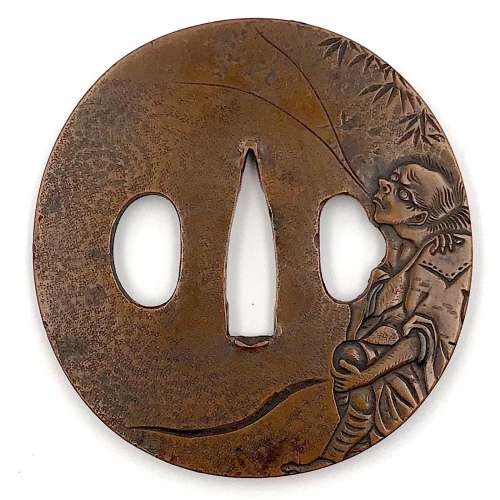
Copper tsuba of oval form carved in kebori and katakiribori with Tekkai Sennin sitting under bamboo on the face and with a pine tree on the back. Ishime-ji treated surface.
Signed on the reverse: Jōi (乗 意).
Edo period (First half of 18th century). Dimensions: 69.6 x 66.5 x 4.5 mm Sugiura Jōi (杉 浦 乗 意) was a master of Nara School in Edo; he was a student of Toshinaga [M. Sesko, 'Genealogies', p. 32]. "Sugiura Jōi (1701-1761) made many fuchigashira and kozuka, tsuba are rather rare." [M. Sesko, The Japanese toso-kinko Schools]. -
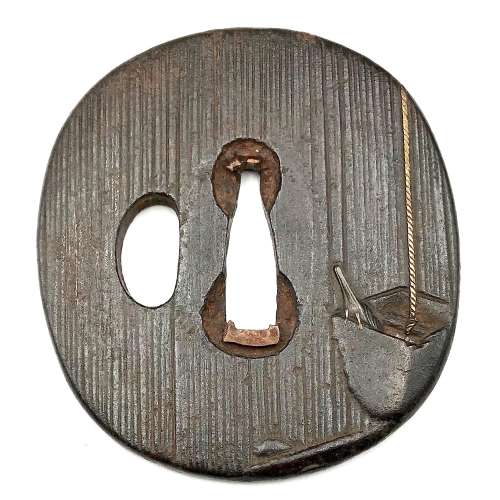
Iron tsuba of elongated round form with brown (chocolate) patina. The surface is carved with file strokes (sujikai-yasurime) to imitate heavy rain. The design of a bird drinking water from a bucket hanging on a rope is carved in low relief (sukidashi-bori); the rope is inlaid in gold. The well structure on the reverse, carved in low relief. Nakago-ana is enlarged and plugged with copper sekigane. Unsigned.
Edo period.Size: Height: 75.1 mm; Width: 68.3 mm; Thickness: 4.6 mm; Weight: 134 g.
Unsigned.
SOLD


